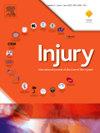Influence of radiation personal protection equipment design on surgeon stress–A randomised repeated-measures crossover study
IF 2.2
3区 医学
Q3 CRITICAL CARE MEDICINE
Injury-International Journal of the Care of the Injured
Pub Date : 2025-01-27
DOI:10.1016/j.injury.2025.112184
引用次数: 0
Abstract
Introduction
Radiation Personal Protective Equipment (RPPE) is the subject of safety guidance from the British Orthopaedic Association (BOA). This pilot study aimed to examine potential performance differences in Trauma and Orthopaedic (T&O) Higher Surgical Trainees (HST) undertaking simulated Dynamic Hip Screw (DHS) surgery related to different RPPE attire.
Methods
Fourteen Higher Surgical Trainees took part in a randomised, repeated-measures, crossover study (8 male, 6 female HSTs) performing two simulated DHS procedures wearing two RPPE attire styles (One Piece (OP) tabard 0.35 mm thickness, and Two-Piece skirt/top (TP), with a 0.5 mm thyroid guard). Primary outcome measures included continuous Heart Rate (HR) monitoring, body temperature, and Visual Analogue Scales (VAS) for comfort and fatigue before and after simulations.
Results
Mean (SD) HR in OP and TP were HR OP 98.8 bpm (10.3) vs. TP 98.1 bpm (10.8, p < 0.001), Maximum HR OP 115.1 bpm (SD 12.4) vs. TP 113.4 bpm (SD 11.9) (p < 0.001). Mean change in temperature were OP 0°C and TP -0.03 °C (p < 0.001). Mean temperature VAS scores in OP were 1.9 (1.7) vs. TP 2.0 (1.4, p < 0.001). Mean Comfort VAS scores were OP 3.1 (2.4) vs. TP 1.7 (2.1, p < 0.001) and Fatigue OP 1.4 (1.9) vs. TP 0.8 (1.5, p = 0.120).
Discussion
Important differences in surgeon physiological measures (HR, temperature) and self-reported measures of comfort and temperature were found related to RPPE style. Understanding the effects that specific RPPE attire has on performance should influence RPPE choice and the findings help inform future research into this important topic.
求助全文
约1分钟内获得全文
求助全文
来源期刊
CiteScore
4.00
自引率
8.00%
发文量
699
审稿时长
96 days
期刊介绍:
Injury was founded in 1969 and is an international journal dealing with all aspects of trauma care and accident surgery. Our primary aim is to facilitate the exchange of ideas, techniques and information among all members of the trauma team.

 求助内容:
求助内容: 应助结果提醒方式:
应助结果提醒方式:


